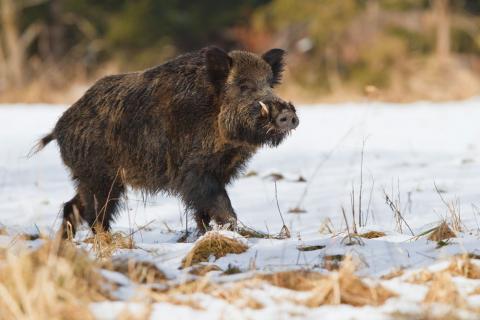Todd Amenrud | Originally published in GameKeepers: Farming for Wildlife Magazine. To subscribe, click here.
Some stand sites (or ground blind locations) can be set months in advance and some may be erected just a couple hours before you hunt. Some hunters also grab a “climber” and just go, picking their stand site when they find it. But then we have those ambush locations that are productive year after year. Some yield during specific times of the season, others seem to be good every time you go there (pending you don’t put too much pressure on the spot). It is possible to create these “slam-dunk” spots on your property. Why are we talking about creating ambush sites for hunting whitetails in the spring issue of GameKeepers? Much can be done throughout the year to enhance ambush locations to produce true hot-spots.
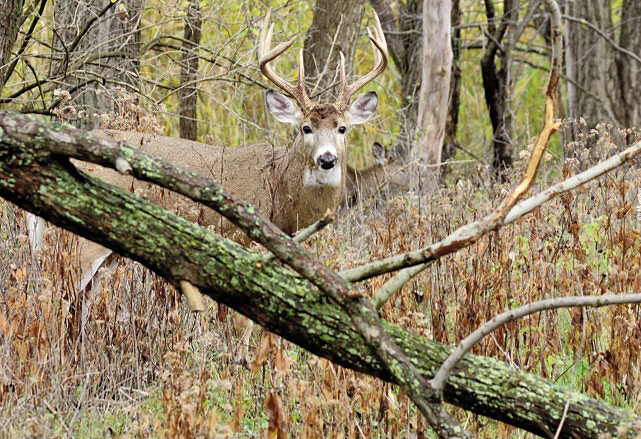
I’m sure many of you reading this have a stand site or are thinking of a spot just like this – maybe it’s a bottleneck, maybe it’s because of a hot food plot location. When it comes to big bucks, my best stand site was one I had in Manitoba. I killed seven Pope & Young bucks in eight years while hunting out of the same tree! The biggest was a beautiful 172 inch 5x5. Then the property was sold and that wonderful run came to an end. I was in a funk for weeks after losing that spot; however, it was the main motivation for beginning the search to buy my own hunting property.
The spot was in a small woodlot along the Red River where three funnels came together. Two were created by the river and open agriculture. The third, where I set up, was created by a creek, and again, open agriculture. A creek that entered into the “murky Red” had eroded a huge 10’ to 20’ foot high cut-bank almost the entire length of the 30 acre wood lot. Coyotes, foxes, river otters and other furry creatures traveled near the bottom by the creek, but deer always seemed to use the top of the cut-bank ridge and you could predict which side of the 250-yard wide funnel they would travel by which way the wind blew. Sure, there were exceptions to the rule, but this was the best “slam-dunk” I’ve ever seen.
While this spot already had most everything required for a bona-fide hotspot provided by Mother Nature, it’s possible for you to create your own prolific ambush locations. There may be certain tasks you’ll need to perform at different times of the year so it’s best to think about these spots often. Just like most real estate deals, it all begins with location. You can take a mediocre spot and with some hard work and time change it into a great spot, but there’s nothing like choosing a good spot to begin with.
Funnels
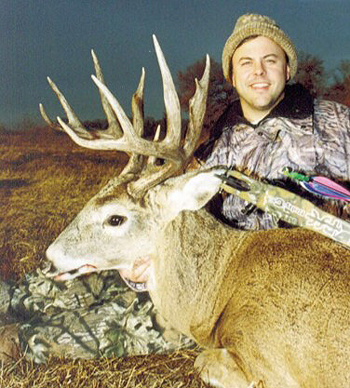
everything it needs to be a long-term, productive
site and no alterations are needed. Here, the author
poses with one of the seven P&Y bucks harvested
out of the same tree talked about in the article.
My favorite “slam-dunk” feature is a funnel. Obviously there has to be a point A and point B - where are the whitetails traveling to and from? Satellite images and topographical maps are the best tools to start with. You’ll also need to do a little scouting, or “best guessing.” You’ll need to have a good idea of where the deer are bedding and where they’ll be feeding or traveling to for other needs.
Anywhere you can restrict their movement to a smaller zone, you’ll obviously see more traffic and possibly more importantly, it’s easier to play the wind. Imagine if you took the three busiest roads coming into the nearest city and brought them down into one lane – there would clearly be much more traffic. And if you curtail their movement it will be easier to position yourself within that zone to remain concealed from their senses. So maps are the place to begin, but funnels are easy to locate with minimal scouting.
These bottlenecks are the best and easiest spots to take advantage of. Remember that these pinch-points aren’t always created by blatant physical obstructions. Sometimes a subtle terrain variation is all you need to influence movement one way or another. So while maps and satellite images are the first place to look, you also have to do some leg-work.
One of the best features of a funnel is the way their movement is limited to a confined region. This makes it much easier to put the wind to your advantage. In fact, if you have four suitable treestand trees or ambush sites in each corner of the funnel area you could theoretically play any wind direction by switching to the downwind and/or crosswind side and end of the funnel - pending thermals are also in your favor.
Be Picky
Just as anglers use structure to their advantage, whitetail hunters must use it even more so. Fish and/or the bait they feed on relate to the bottom composition much of the time, but I would argue that whitetails use structure at all times. Where fish are sometimes suspended in space following bait or because of water temperature issues, whitetails ALWAYS use structure. So when finding an exceptional site that might remain productive for years to come, we’re not just looking for the spot, we’re looking for “the spot on the spot”…the perfect location.
Other structures such as ridge saddles, edge changes and ecotones, inside turns or points, creek crossings, gate openings or fence crossings, timbered areas recently cut, access to escape cover and other terrain features can also offer places for good long-term hot-spots. A bit of scouting will be required to find the place, but you really won’t know for certain until you examine camera data or it’s hunted. Don’t be afraid to reposition if need be.
Improving a Mediocre Spot
It’s possible to take an ordinary spot and make it significantly better with plant diversity, doing woods-work, creating stoppers to help with harvest opportunities, cutting trails, planting edge cover and effectively camouflaging the site. One of the most significant factors in the difference between run of the mill sites and a long-time prolific ambush location is the ability to remain hidden from a whitetails’ “olfactory offense.” Whether it’s having multiple stands or blinds at a given site (as mentioned before regarding funnels) or amending the location to your advantage, being able to remain concealed from your quarry is arguably the most important detail in getting shot opportunities. And although you’ve heard it a thousand times before, it’s TRUE, a whitetail’s sense of smell is by far and away their most acute and difficult to deceive.
Besides finding a spot that puts you downwind or cross wind of where you believe whitetails will travel, creating “detours” that discourage travel into unwanted areas (mainly downwind of you) or creating trails to encourage movement in a particular direction will greatly enhance a site.

Sometimes you must hunt a spot a few times before you know exactly how travel patterns work with specific winds and how you would like to divert traffic, but hinge-cutting trees is my favorite way to channel movement around my stand sites. If there is a significant trail passing your location, in addition to blocking travel by hinge-cutting selected trees, I would suggest enhancing a new trail exactly where you would prefer travel to take place. Whitetails take the path of least resistance just like other animals, and if you construct one for them they’ll use it. It’s simple, block off areas where they have the best chances of locating your position and encourage them to pass through where you will have the advantage. This tactic can also work to give you the advantage of the sun and help to hide you in situations where there is less than desired concealment. Simply felling trees can block travel, but hinge-cutting works best to “fence-off” an area if you’re able.
A pruner, axe or machete will work to produce new trails, but a weed-trimmer with a “brush blade” is often the best tool for the job. I first learned how effective making trails could be many years ago - I began creating silent approaches for myself so I could sneak to my treestand undetected. The deer began using my trail over their own. The problem with the deer using my approach trail is they walk directly towards the tree, never offering a shot. Since discovering this, I lead the trail past my site and create a 90° offshoot to the stand. Redirecting travel by creating trails is not only a very effective way to protect yourself from being discovered, but also a way to direct more deer past your location within effective kill-range.
Taken them to the Edge
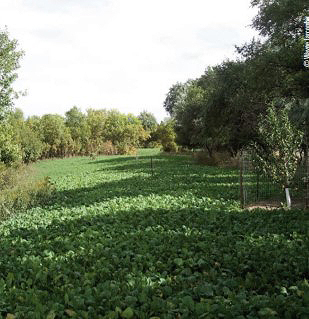
the highlights here that make a great stand
site – several edges leading straight into his
location, along with fruit trees and a hot food
plot for attraction and stoppers.
We all know that whitetails love to travel the “edge” and the ecotones between two plant communities. Since whitetails follow edges, give them one to follow. These edges can be created quickly or with a long-term plan in mind. It depends upon whether your location is back in the timber on a ridge-top or maybe along the edge of a food plot. This edge cover can be created with a chainsaw, herbicide, disking, or by planting various plants, shrubs or trees. Again, it depends upon your location and time horizon.
If you’re in the timber and there’s enough light making to the spot, I like to plant conifer trees. Think of your stand location as the center of an old wagon wheel and introduce lines of conifer trees as the spokes. Various varieties of spruce, pine, cedar or fir make good selections. Whitetails will begin to follow this evergreen line and it’s a great long term highlight to add to your ambush location.
If you’re in the timber and there’s enough light making to the spot, I like to plant conifer trees. Think of your stand location as the center of an old wagon wheel and introduce lines of conifer trees as the spokes. Various varieties of spruce, pine, cedar or fir make good selections. Whitetails will begin to follow this evergreen line and it’s a great long term highlight to add to your ambush location.
With a food plot location or with other open, “plantable” ground a very quick solution is to plant annual grasses. Quick, simple, inexpensive solutions that I like to use are WhistleBack and Blind Spot. Not only will these supply cover, food and edge for structure, but they also make excellent concealment for you to slip in and out of your site without detection.
If hunting the edge of a food plot, crops like corn, sorghum or sunflowers will work to create excellent edges that whitetails will follow. Another tactic often employed is to mow lanes through these taller crops. Rather than planting strips of these tall grass crops to form an edge, the edge will be created by mowing lanes through the standing crops. Either way will work, it depends upon your food plot needs for the year as to which would be best to employ.
Happy Hour
My notion is to continuously enhance a spot to give whitetails incentive to show up more often and stay longer in the area. Think of a whitetail’s needs and give them a reason to hang around. Food, water and cover are all draws to deer and all can be added to your stand site area.
Water is something all animals need and can be simple to add to an area. You may want to go as elaborate as a using a front-end loader and pond fabric to as simple as digging a hole in the ground in the proper spot. Something in-between can be very effective – I like to dig a hole large enough to place in a cow water trough or half of a barrel. Place them in a spot where they will naturally collect rainwater. If you have whitetails in the area, there is obviously water somewhere nearby, but this can be an extra draw that just adds to the attraction power of the site.
Two great ways that we can add extra food are planting mast trees or simply allowing the sunlight to hit the soil. Hard mast like acorns or soft mast like apples can change the spot from one where deer were just passing through into a destination feeding site. And taking out some of the canopy to allow sunlight through will naturally “detonate” the stem density – this means more food and added cover. Adding plant diversity to the site will enhance wildlife utilization for all animals. The simplest way to put it is - remove undesirable plants and trees that do not benefit your chosen species and add plants and trees that do.
Plan for the Kill
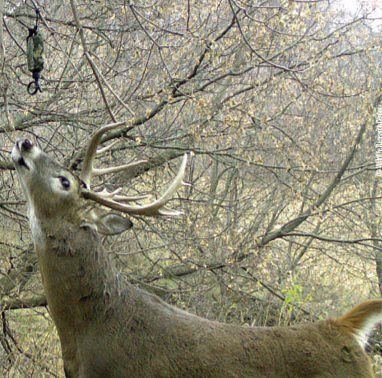
Create several “stoppers” around your location to halt
the animal for a shot. Productive mast trees, sign posts
and licking branches make great “stoppers” that will
significantly increase your odds.
If a “once in a lifetime” buck ambles through and you can’t get a shot…well you get the idea. Make sure you have adequate shooting lanes. You don’t want to mow the entire area free of brush - that would be the absolute wrong play. Just make sure you have “alleys” or “windows” to high percentage points. Use the hinge-cut trees we talked about to guide animals exactly where you want them and the “stoppers” we’ll talk about now to position the animal exactly where you want them.
Mast trees, scent posts and licking branches all make great stoppers. If you have a manufacturing oak tree within range, it’s likely that every deer that travels through will stop to vacuum up as many acorns as feasible. Make sure you can easily shoot to where the acorns are falling.
Use last season’s unused lures and scents to create a “sign post.” Just like almost every other animal in the field, whitetails declare their territory by urinating at designated sign posts. I keep my old lure in my ATV and use it to create sign posts each time I travel by a stand site. Make sure it’s within easy range where you have a clear shot. The base of a large tree seems to work well. It doesn’t have to be plain deer urine, fox pee, coyote urine or even left over Special Golden Estrus will work. All animals want to mark their territory and you will see fox, coon and deer begin to use the spot – all of them want to declare “I live here too!”
An overhanging branch or “licking branch” is another great stopper. Again, make sure you have a clear shot and it’s within range. In fact, it may be advised to remove other licking branches in the area to make the one at the kill site the focus. A Magnum Scrape Dripper hanging above it dispensing some Active Scrape can help to seal the deal.
Keep it on the Low-Down
Lastly, you must make sure your ambush location stays well hidden. This not only means camouflaging it, it also means hunting it sparingly. You can’t hunt the same spot too often or during the wrong conditions and expect it to remain productive. Only hunt it with the wind and thermal in your favor and rest it for a spell after it’s been disturbed. Plan for long term progression of the site; for instance, trees or cover growing, trees dying, food source changes, stand or blind repositioning, etc. And remember, a little work now can pay huge dividends this coming season and for years to come.















